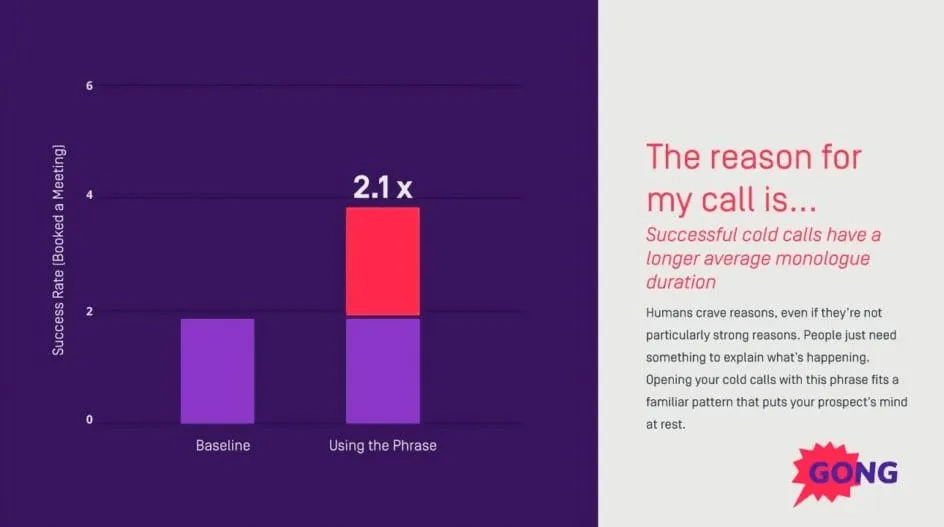
Top-performing salespeople know that the best cold call opening lines are the ones that pull your prospect into the spotlight.
After all, this call is an unexpected interruption from their day. They have no reason to keep listening to you—until you give them one.
Outbound sales reps and SDRs who respect their prospect’s time will prep in advance for the call, maybe do a bit of research on social media (like LinkedIn), and know exactly what to say on that cold call before the person answers the phone.
Looking for a way to boost your B2B sales conversion rates? Start at the beginning of your sales process—a successful cold call.
What to Say on a Cold Call: 5 Steps to Start Your Sales Call
Wondering how to start a cold call? Those first seconds are critical. The lead wasn’t expecting your call, and they’ll need solid reasons to stay on the phone with you.
Head over here to get much more detail about how to create a cold calling script that works. But for now, here are five easy steps to start your cold call sales pitch on the right foot:
Step 1: State Your Full Name and Where You’re Calling From
While a bit obvious, giving your name and your company’s name in the first sentence is essential, especially when you’re on the phone. Your lead needs to know immediately who you are and what company you’re with: otherwise, they’ll spend the first 20 seconds wondering who on earth you are and will completely miss your pitch, or worse, hang up without hearing you out.
For example, “Hi, I’m Bruce Wayne calling from Penguin’s Paper Products.”
Step 2: Explain the Purpose of Your Call in One Sentence
There’s no need to ask if you caught them in the middle of something—just assume you did. After telling them clearly who you are, give a one-sentence explanation of why you’re calling them.
Are you calling on a referral? Fantastic, name that person. Are you calling this lead after sending a cold email? Mention that email.
This sentence needs to cover three important points:
- What you’re offering
- Why you’re calling this particular person
- What the goal of the call is
That sentence could sound like this:
“The reason for my call is to speak with the person in charge of ordering paper products for your company, such as toilet paper and paper towels.”
(Don’t worry, we’ll give you eight more examples of the best cold call opening lines down below.)
Of course, this piece of your sales script is also essential if you get sent to voicemail. Prepping a quick explanation of the purpose of your call, using the prospect’s name, and asking them to call back is a simple yet effective voicemail script you can use every day.
Hey there! If you're serious about cold calling, our article spotlighting the top 8 sales headsets is your compass.
Step 3: Tell Them Exactly How Much Time You’ll Need
This is a psychological hack sales teams can use to help the prospect feel at ease.
Telling the other person exactly how much time you’ll need upfront provides instant reassurance, so prospects know that the call won’t take longer than necessary and that you’re respecting their time.
Consider a time you got a call from someone that you know will keep you on the phone for hours. Imagine that every prospect assumes this from the start and counter their objection to “not having enough time” early on. How can they know if they don’t have enough time if they don’t know how long you’ll need?
Always assume your prospects have had bad experiences with lousy salespeople who have kept them on the phone much longer than they wanted, and they’re ready to make their excuses and get off the phone with you before you take their whole day.
To stop this from happening, tell them exactly how much time you’re asking for. Try to use odd numbers. Saying, “This will only take a few minutes of your time” or “60 seconds” seems generic.
“If you have 3 minutes right now, I can share with you how we saved 73% of our customers more than 20% on their paper needs in the last six months.”
Of course, if they agree to listen to you, stick to the time you promised. This shows you respect them and builds trust.
Should you still get the “too busy right now” line from the prospect, sympathize with their busy schedule and ask for a better time to reach back. Be sure to offer a specific time/day.
Pro tip: This is one time an open-ended question is discouraged!
"Are afternoons better for you? How about Tuesday around 2 or 3 p.m.?” is much better than “How about next week?” which is likely to lead to yet another “too busy right now” conversation. If you mutually agree to a time, the prospect will be more likely to take your call because they already agreed to it.
When you log your call in your notes or CRM system, be sure to note that they were very busy so you can reference how busy you know they are, and then point out how your product or service will save them time.
Pro tip: Enhance your cold calling with Close's new AI-powered Call Assistant. It automatically transcribes recorded calls for easy review, generates summaries, and allows keyword searches across all transcripts.
 |
Step 4: Give Your 30-Second Sales Pitch
If the potential customer agrees to hear your pitch, do not go beyond the time you’ve set for yourself. In 30 seconds or less, give a solid pitch that focuses on the needs and wants of the lead and shows them specific reasons why they should stay on the phone.
Your pitch should include a brief overview of your product/service’s value proposition, and may even include a case study or some other type of social proof.
Such as, “We base your paper product pricing on volume pricing over the entire year, not order to order. These savings can be significant. For example, we saved Gotham College more than $18,000 last year.“
Step 5: Ask for Permission to Continue
Within the first 90 seconds of the call, your lead knows who you are, where you’re calling from, what you’re offering, and why you called them today. This is all the information they need in order to decide whether they want to keep listening or not.
At this point, you cannot keep pitching without better knowledge of the customer. You need to ask qualifying questions so that you’re not throwing darts in the dark and can keep building rapport with your customer.
But first, you need to make sure they’re willing to continue. It’s time to ask a critical question: “Does this sound like something you’d be interested in?”
If the answer is no, be polite and suggest a future follow-up call, and then hang up. Document the outcome on your list (using your CRM software if you have one).
This method quickly establishes a basis to continue the conversation and present an effective sales pitch, leading to a closed deal.
These cold calling tips are just the beginning: keep reading to see real templates you can use to start a cold call.
8 Best Cold Call Opening Lines to Get Your Prospect’s Attention
You’ll say a lot between “Hello” and “Goodbye” on your phone call, but the key line that will make or break your cold calling success is the phrase you choose to explain the purpose of your call.
Wondering what to say after you state your name and where you work? Here are 8 of the best cold call opening lines proven to get more positive responses.
(Note: These lines will also work if you can’t reach your intended prospect and have to speak to a gatekeeper at the prospect’s company instead.)
1. “I Only Have A Minute, But…”
You’ve probably heard of (or used) the line “I’ll only take a minute/30 seconds/10 seconds.” The problem with this line is that you’ve lost the grip over the conversation by telling the prospect, “If I take longer, you’re right to hang up.” You’re also limited to the time you’ve promised, meaning that you’ll have to throw up data about your company and hope for the best.
But if you say that you, as the caller, are short on time, you won’t only be empathizing with your prospect by acknowledging how busy they are, you’ll also get them excited about what you’re going to say next.
If you’re so busy, your call must be about something important. Once you’ve got your prospects waiting for what’s so important, you can tell them why you’ve called them, which leads to your short sales pitch.
2. “The Reason I’ve Called Is…”
“Get to the point.” This is what your prospects are thinking once you’ve told them your name and the name of your company. In many cases, people won’t even listen to what you have to say until you tell them why you’re calling. That’s why directly telling them the reason, just like ripping off a band-aid, is usually productive.
In fact, starting this sentence with “The reason for my call is…” has actually been proven to help prospects stay on the phone longer and even book a meeting.
 |
But be careful about how you phrase your reason. Don’t say something generic like, “Our company helps companies like yours.” Be specific and target pain points: “We help companies like yours reduce churn and increase customer retention.” Now you’re talking about an issue that your prospect cares about.
3. “(Name) From (Company) Recommended That I Contact You Since We’ve Helped Them…”
This is the referral line: Even if you got a referral from a client, it’s still technically cold calling since you don’t know the prospect yet, and they haven’t expressed interest in your product directly.
This is one of the most effective lines as prospects are likely to trust the people who referred them to you–in fact, 84 percent of B2B decision-makers start their purchase with a referral.
Dropping the name of someone the prospect knows at the beginning of your call has the same effect as a referral strategy. If the prospect’s friend trusts your brand enough to give you their information, the prospect will trust you and so listen to you, too. Don’t forget to direct your focus to the prospect and what you’re offering them right after you mention the referrer.
Once you’ve filled in the names, this line sounds like: “Hi John. This is Sam Smith from X Company. Josh from Z Company recommended that I contact you since we’ve helped them optimize their demand generation strategies with our SEO tool.”
4. “I’m Calling Since We’ve Helped (Competitor) With (Pain Point) Recently, And We Can Help You With This Issue Too.”
Chances are that you won’t have a referral for every prospect. However, you’re likely to be working with your prospect’s competitor or a related business, and this is something you should take advantage of.
Competitor analysis is one of the most important aspects of marketing, especially in the ever-growing SaaS industry. Your prospects are aware of this, and they want to know what their competitors are doing so that they don’t fall behind.
If you tell your prospect that their number one competition has fixed a common problem of theirs with your tool, they will keep listening to make sure that they’re not missing out.
In a call, this line sounds like this: “Good morning, John. This is Sam Smith from X Company. I’m calling because we’ve recently helped Competitor Company with their recurring revenue leakage, and I thought you could use our help with this issue too.”
5. “I’m Glad I’ve Reached You, I’m Going To Ask For Your Help With Something.”
Asking for your prospect’s help sounds counterintuitive since you’re trying to help them with your products. However, this line works for three main reasons.
- It incites curiosity: the person on the other side of the line starts wondering what you could want from them.
- It makes them feel important. You’re asking them for help, not anyone else.
- It’s easy to hang up on someone who just wants to sell you something, but it’s harder to hang up on someone who is just asking for your help. Prospects are likely to say yes to make themselves feel better.
This line and those that should follow can look like: “Hi John. This is Sam Smith from X Company. I’m glad I’ve reached you, I wanted to ask for your help with something.” “Sure.” “Our company has found that the most common problem for businesses like yours is driving leads down your sales funnel. I wondered if you agreed and could tell me about your experience.”
This start is especially strong since you made the call about the prospect and not about your brand.
6. “Hi, We’ve Never Spoken/Met Before. I’m Just Calling To See If I Can Arrange A Call With You Next Week.”
This line states the obvious, but it works because it’s honest and direct. It makes you sound more trustworthy as you’re laying your cards on the table: What you’re saying is that this is essentially a cold call, but you don’t want to interrupt the prospect’s busy schedule (the “if I can arrange a call with you” part implies this.)
After this initial line, pause to spark curiosity. The prospect will probably ask you, “About what?” and you’ll start explaining what you’ll be talking about in your future meeting or discovery call, which is your company’s products and services.
7. “I Wanted To Congratulate You On Your Recent Promotion…”
This is just one of the many personalized lines you can use. Other variations can include something you have in common with your prospect: maybe you went to the same college, or maybe you’re from the same town. Or, you may talk to them about how long they’ve been working in their company and how they like it.
Whatever the personalized line is, it gets prospects to open up and trust you enough to listen to what you have to say next. It’s also harder to hang up on someone with who you feel a personal connection, even if that connection is a weak one. As I’ve said previously, researching your prospects is required.
8. “How Have You Been?”
While a controversial one, this line performs the best statistically: sales conversations opening with “How have you been” had a success rate of 10 percent, compared to the 1.5 percent baseline, according to Gong.
This line baffles your prospect as it implies that you’ve met before. This may sound contradictory, especially after the honest “We’ve never spoken before” line. However, you’re still not lying to your prospect. If they’re in an incredibly good mood, they’ll answer your question. But they’ll probably ask how you know them or why you’ve called, setting the ground for your pitch.
With these cold call opening lines, you’ll grab your prospect’s attention and get them ready to listen.
Cold Calling FAQ
What is a good cold call example?
“Hi [Prospect’s Name]. This is [Your Name] from ABC Company. I only have a minute, but I wanted to tell you that we’ve helped [Related Business] with [pain point] recently, and we want to help you with this issue too.”
What shouldn’t you say on a cold call?
When cold calling, avoid asking if the person has time to talk or if it’s a bad time. Assume you caught them in the middle of something. Also, try not to talk too much about yourself or your company—after clearly stating who you are, focus on solving a clear pain point for the prospect.
What do you do in the first 20 seconds of a cold call?
State your full name, and where you’re calling from. Use one sentence to explain why you’re calling, and tell them exactly how much time you’ll need. Then, ask for permission to continue.
Maximize Your Cold Calling Power
There’s more to cold calling than trying to sound confident or prepping your objection-handling techniques. To succeed, you need to care about your prospect’s pain points, believe in the solution you’re offering, and create a cold calling script that helps you explain that concisely
The cold call opening lines above will give you a head start, but keep in mind that effective cold calling is also about trial and error. While these lines are usually successful, you’ll have to tweak them according to your own calls’ success.
Keep a log of all the calls you make and repeatedly use the same opening line to see how it performs, make adjustments, and repeat the process.
And lastly, don’t be discouraged if your opening lines don’t work at first. The most successful cold callers are the ones who’ve failed enough times to know what works!
Psst… Looking for the right software to maximize your cold calling efforts? Try Close’s Power and Predictive Dialers, and see how the power of automation can 10x your outreach potential.









